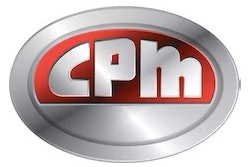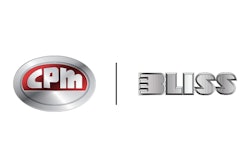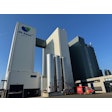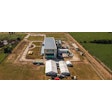Looks can be deceiving. Such is the case as you approach NEW Cooperative’s brand new feed mill in Pomeroy, IA, from the south. You can see the feed mill towering in the backdrop, but from this angle the dominating sight is NEW Cooperative’s 3.25-million-bushel grain elevator and storage facility. What lies beyond that is a 180-foot-tall mill, featuring state-of-the-art equipment from receiving through milling and grinding, to mixing and batching, and onto load out.
You can’t tell from the outside how many customized, truly unique, solutions play a crucial role in the operations of this facility. Some were spurred by the harsh winter climate in central Iowa, and others came simply out of a desire to maximize the efficiency of the space and equipment.
But, one thing you can tell from just one conversation with NEW Cooperative’s management is that every decision was made with its 4,400 members (located in central and west-central Iowa) in mind.
“At the end of the day, NEW Cooperative strives to add value to our members’ farm operations,” said Kent Nolting, feed division manager. “The driving force behind building this feed mill was to provide a market for member’s grain.”
New market for members
In 2014 NEW Cooperative recognized an unmet demand for hog feed in the area. With an abundant corn base surrounding Pomeroy and the existing assets at the grain elevator, it only made sense to add a feed mill to the location.
The cooperative selected Younglove Construction, L.L.C. as the design/builder/contractor. Along with Younglove’s engineers, Nolting and Zach Stuchlk, NEW Cooperative’s feed division operations manager, were instrumental in the overall design of the facility.
“We brought a lot of our past experiences into this facility to make it run efficiently, produce high-quality feed, and most importantly, load out trucks quickly and keep them on the road,” said Nolting.
Construction crews broke ground in September of 2015, and after an 18-month construction phase, the mill came online in February 2017.
The main features include a slipformed concrete mill tower, two loading bays, a receiving/grinding building rated at 12,500 cubic feet/hour, 22 ingredient bins and a 20-bin load out with a capacity of 2,200 tons.
Key equipment on-site includes a pair of Bliss hammermills, a tripledeck RMS roller mill for mash feed productions, a 20-bin CPM Beta Raven microingredient system, a 9-ton Scott Equipment Co. mixer rated at 150 tons/hour, two CPM pelleting lines, with APEC fat coater and a Bliss counterflow cooler, all controlled by a CPM Beta Raven automated control system.
Receiving capabilities
The ingredient receiving house consists of an 80-foot Rice Lake Weighing System platform scale with a dump pit rated at 250 tons/hour. Nolting said it takes less than 10 minutes to receive a load of ingredients. Meanwhile, all grain receiving takes place at the adjacent grain elevator and is conveyed over to the mill on Essmueller Co. drag conveyors.
Liquid ingredient receiving is done in a unique way to help prevent spills and keep liquid ingredients out of the elements.
“Our liquid receiving lane has contours for spill containment centered all around the area, and the trucks hook up [to load the liquid ingredients] through the doors on the other side of the wall,” Nolting said.
The liquid ingredients are pumped in the storage containment area, and each tank has its own fill area that goes through a filter.
“We had a desire to keep this inside because when it’s wet or icy there can be slipping and falling hazards,” said Stuchlk. “When this is outside it’s harder to maintain. We never have to worry about the elements, we keep it clean and the liquid’s contained.”
Inside receiving, there are three 11,000-gallon liquid storage tanks and two 20,000-gallon liquid fat storage tanks. The room was designed large enough to install additional liquid ingredient and fat tanks in the future if needed.
Custom warehouse feature
All 3 million bushels of corn and grain storage is located on the elevator side, and microingredients are stored inside the mill’s 5,000-square-foot bagged ingredient warehouse.
Fast-moving ingredients are stored in bulk-sized totes, which are placed inside giant plastic crates that can easily be moved around by a pallet jack to be emptied into the microingredient system through grates in the floor. This unique system was customized for NEW Cooperative by CPM Beta-Raven.
“This saves time because you don’t have to lift [the tote], hang it and open it up,” Stuchlk said. “You just pull one out with the forklift, glide it over and open the slide gate.”
A freight elevator also moves bagged ingredients on pallets up two floors to be mixed into the feed with a 9-ton Scott mixer.
Loadout: a different way to weigh
The Pomeroy facility has 20 loadout bins containing about 2,200 tons of finished feed with two loadout lanes and weigh lorries to fill their 27-ton Walinga truck trailers.
Incoming trucks are identified by an RFID tag so the company can track how many loads it delivers, track its biosecurity requirements for FSMA and for load sequencing.
Pomeroy operates a fleet of 10 trucks, owning seven of them and contracting three out. The automated CPM Beta Raven load out/weigh lorry system is quite user-friendly and takes drivers only eight minutes to load out, according to Nolting.
“The operator will come into the load out control room, sign in, pull up the load that’s assigned to him, cue it to say that he’s ready to start loading, and then the system will take off from there and load the truck.”
Once the weigh lorry suspended above the trailer is filled with 9 tons of finished feed, it dumps it into the first section of the trailer.
The robotic load out spout moves onto the second and third sections of the trailer, completing the 27-ton load.
As was the case with the liquid ingredient receiving process, the local winter weather went into the decision-making process of their loadout equipment.
“The weigh lorry is easy to operate, it’s quick to load, and probably the most important thing in Iowa is it’s not sitting on a platform scale that has a tendency to freeze up in the winter,” said Nolting. “When truck traffic is in the elements or bringing in road dust, it can freeze up a platform scale, so all our weighing apparatus is above the truck.”
Nolting says NEW Cooperative’s feed customers, mostly integrated hog operations in the area, have been impressed with product quality, consistency and the level of service they’re received from the new Pomeroy feed mill.
“This facility has all the latest technology in the market right now, but I think more importantly for NEW Cooperative, is it continues to enhance and build our network of feed mills that gives our
members a continuance plan for customer changes,” said Nolting.
By drawing on experience from past successes and addressing problems that require unique solutions early on, NEW Cooperative was able to work smarter, more efficiently, and achieve higher customer satisfaction with its fifth feed mill. ❚
REPLICATION EFFORTS UNDERWAY
If imitation is the highest form of flattery, NEW Co-op’s Pomeroy feed mill is about to receive quite the compliment. Construction of a nearly identical facility is underway about 90 miles east at its Rowan, IA, grain elevator.
The project will involve construction of a 180-foot mill building that will house two 40-ton/hour pellet systems, 2,000 tons of ingredient storage space and 2,200 tons of load-out space. Once operational, the mill will have a total production capacity of 400,000-plus tons of pelleted feed per year. The pelleting feed mill is expected to add up to 14 new employees.
The NEW Cooperative Rowan location was chosen as the site for the new mill due to access to utilities, availability of land, and the existing grain assets at the facility.
“It’s the same concept as the Pomeroy feed mill,” explains Kent Nolting, feed division manager, NEW Cooperative, Inc. “We had a market where we felt we could do better in corn marketing, and so we went into a location that was underserviced by existing feed operations, and thus it’s the perfect market for us to expand into.”
NEW Cooperative expects the Rowan feed mill to be completed by the summer of 2018.



















